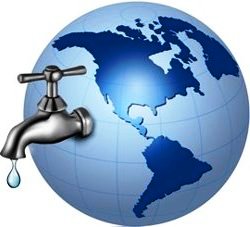 Water is used around the world for the production of electricity, but new research results show that there will not be enough water in the world to meet demand by 2040 if the energy and power situation does not improve before then.
Water is used around the world for the production of electricity, but new research results show that there will not be enough water in the world to meet demand by 2040 if the energy and power situation does not improve before then.
Two new reports that focus on the global electricity-water nexus have just been published. Three years of research show that by the year 2040, there will not be enough water in the world to quench the thirst of the world population and keep the current energy and power solutions going if we continue doing what we are doing today. It is a clash of competing necessities, between drinking water and energy demand. Behind the research is a group of researchers from Aarhus University in Denmark, Vermont Law School and CNA Corporation in the U.S.
In most countries, electricity is the biggest source of water consumption because the power plants need cooling cycles in order to function. The only energy systems that do not require cooling cycles are wind and solar systems, and therefore one of the primary recommendations issued by these researchers is to replace old power systems with more sustainable wind and solar systems.
The research has also yielded the surprising finding that most power systems do not even register how much water is being used to keep the systems going.
The first report, “Capturing Synergies Between Water Conservation and Carbon Dioxide Emissions in the Power Sector”, focuses on strategy recommendations based on analyses of water use and CO2 emissions in four case studies, which are detailed in the second report, “A Clash of Competing Necessities: Water Adequacy and Electric Reliability in China, India, France, and Texas”.
By 2020, the Water Issue will Affect 30-40% of the World
“It’s a huge problem that the electricity sector does not even realise how much water they actually consume. And together with the fact that we do not have unlimited water resources, it could lead to a serious crisis if nobody acts on it soon,” says Professor Benjamin Sovacool from Aarhus University.
Combining the new research results with projections about water shortage and the world population, it shows that by 2020 many areas of the world will no longer have access to clean drinking water. In fact, the results predict that by 2020 about 30-40% of the world will have water scarcity, and according to the researchers, climate change can make this even worse.
“This means that we’ll have to decide where we spend our water in the future. Do we want to spend it on keeping the power plants going or as drinking water? We don’t have enough water to do both,” says Professor Benjamin Sovacool.
Close-up on France, the U.S., China and India
The team of researchers conducted their research focusing on four different case studies in France, the United States, China, and India respectively. Rather than reviewing the situation on a national level, the team narrowed in and focused on specific utilities and energy suppliers. The first step was identifying the current energy needs, and then the researchers made projections as far as 2040, and most of the results were surprising. All four case studies project that it will be impossible to continue to produce electricity in this way and meet the water demand by 2040.
How to Solve the Problem?
In the reports, the researchers emphasise six general recommendations for decision-makers to follow in order to stop this development and handle the crisis around the world:
- Improve energy efficiency
- Better research on alternative cooling cycles
- Registering how much water power plants use
- Massive investments in wind energy
- Massive investments in solar energy
- Abandon fossil fuel facilities in all water stressed places (which means half the planet)
In addition to addressing the water use concerns, the recommendations, if implemented, would also yield other benefits, most notably reduced carbon dioxide emissions as well as cuts in emissions of such pollutants as sulphur dioxide, nitrous oxides, particulate matter, and mercury.
“It’s a very important issue,” said lead study author Paul Faeth, Director of Energy, Water, & Climate at CNA Corporation. “Water used to cool power plants is the largest source of water withdrawals in the United States and France, and a large source in China and India,” said Faeth. “The recommendations in these reports can serve as a starting point for leaders in these countries, and for leaders around the world, to take the steps needed to ensure the reliability of current generating plants and begin planning for how to meet future demands for electric power.”
Check the following links to read/download the Full Reports:
Capturing Synergies Between Water Conservation and Carbon Dioxide Emissions in the Power Sector
Source: Aarhus University, Vermont Law School and CNA Corporation.

















